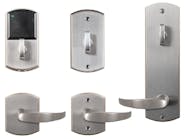Ilco, a member of the Kaba Group, has introduced the patent pending Bump Halt™ specialized top pin design to resist Ilco mortise, rim, key-in-lever and key-in-knob lock cylinders from being opened using the “key bumping” method.
A generic definition for “key bumping” is a method to unlock a conventional pin tumbler lock cylinder without the properly coded key. Key bumping requires a specially cut “bump key,” a key that has deep cuts and pointed separations between adjacent cuts. These pointed separations are used as a ramp to raise the top and bottom pins when the inserted “bump key” is either rapidly pushed forward or retracted. The short rapid movement of the key provides the force necessary to accelerate the pin tumbler movement.
When a “bump key” operates properly, there is a moment in time when the top pins and bottom pins separate, the bottom pins are within the plug while the top pins remain within the lock cylinder’s housing. At this moment, the shear line is not obstructed (clear), permitting the plug to be rotated.
“Key bumping” will only work when the shearline is unobstructed, having the pin tumblers above and below.
Ilco Bump Halt resists “key bumping” by using stronger, longer coil springs in conjunction with unique-shaped top pins. The Bump Halt springs exert a different amount of resisting force than the standard pin tumbler springs when pressure is exerted during a “key bumping” attempt. The desired result is that at no point in time does the shearline become unobstructed. There will always be a top or bottom pin crossing the shearline.
Additionally, the Ilco Bump Halt top pins play a significant role in key bumping resistance. These top pins have a unique shape. Unlike standard top pins that are cylindrical with a chamber on each end, Bump Halt pins have a slightly rounded bottom with a small rise (to keep it centered within the pin chamber). The remainder of the upper portion of the pin has been machined down to less than 50 percent, forming a shaft which extends from the center of the rounded bottom. This shape accommodates the Bump Halt longer spring to extend over the shaft to the base of the Bump Halt top pin.
Depending upon the manufacturing variations of each lock cylinder, this narrowed dimension can permit the plug to rotate slightly farther when an attempt is being made to “key bump” the lock cylinder. This slight additional rotation will cause a restriction in some of the pin chamber pathways. This can affect the movement of the top and bottom pins, causing the top and bottom pins to not move in unison. Since the top and bottom pins do not move at the same time or have the same velocity, the result is that the shear line remains obstructed. In conjunction with the stronger, longer spring, this can prevent the lock cylinder from being bumped open.
To modify an Ilco lock cylinder to being bump resistant, the spring and top pin from one pin chamber must be removed and replaced with the Bump Halt top pin and spring. No special tools or modification is required to the lock cylinder. Ilco recommends using a pin chamber, starting with the second space, which contains a number 3 or smaller bottom pin.
According to Ilco, “Only one spring and one pin are required to resist bumping; installing two pins and springs increase the security.”
Bump Halt Cylinder Kits come in two sizes; one for mortise and rim lock cylinders, the other for key-in-knob and key-in-lever lock cylinders. The Bump Halt Cylinder Kit part numbers are 1500BH-00-10 for key-in-knob and key-in-lever lock cylinders. The mortise and rim lock cylinder kit part number is 7000BH-00-10. Each Bump Halt Cylinder Kit contains ten springs and top pins.
According to Ilco, “Bump Halt technology has been designed by Ilco specifically for Ilco lock cylinders. Although this technology may work with other brands of cylinders, this condition has not been tested and is not known to resist “bumping.”
Ilco lock cylinders can be ordered with Bump Resistant Technology. Contact your local locksmith wholesaler for more information.




